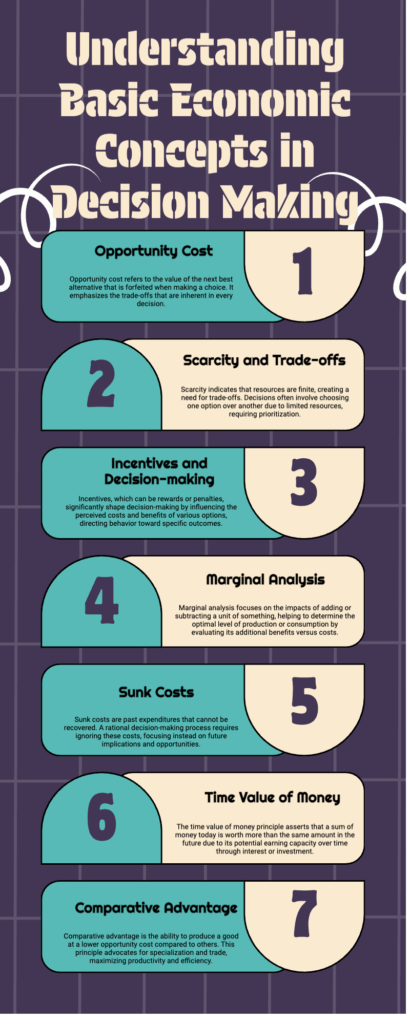Have you ever wondered why people make certain choices? Why do some individuals save money, while others spend it all? Why do companies invest in new products or services? The answers to these questions lie in the realm of economics and decision-making.
Economics is not just about money; it’s a way of thinking that helps us understand how people make choices. Economic concepts play a crucial role in deciding what to eat for breakfast or whether a company should expand into a new market.
In this blog post, we’ll explore some basic economic concepts that can help us make better decisions in our daily lives. We’ll learn about opportunity cost, scarcity, incentives, and more.
1. Opportunity Cost
Imagine you have $10 to spend. You could buy a pizza or go to the movies. If you choose the pizza, the opportunity cost is the movie you gave up. Opportunity cost is the value of the next best alternative you didn’t choose.
In economics, every decision involves an opportunity cost. When you choose one option, you’re giving up the opportunity to pursue the next best alternative.
Here’s an example:
Sarah has $20 and wants to buy a book or a video game. The book costs $15, and the video game costs $20. If she buys the book, her opportunity cost is the video game she didn’t buy.
Understanding opportunity cost is crucial for making informed decisions. It helps us recognize the trade-offs involved in every choice we make.
2. Scarcity and Trade-offs
Resources are limited. There’s only so much money, time, and effort. This concept is called scarcity.
Because resources are scarce, we have to make trade-offs. We can’t have everything we want, so we must choose what’s most important.
For example, if you have $100 to spend, you might have to choose between buying a new video game or saving the money for a rainy day. You can’t have both because your resources (money) are limited.
Trade-offs are at the heart of economics. Every decision involves giving up something to get something else.
3. Incentives and Decision-making
Incentives are rewards or punishments that influence our behavior. They play a significant role in the decisions we make.
For example, if you get a good grade on a test, your parents might reward you with a special treat. This incentive encourages you to study hard and do well in school.
Companies also use incentives to motivate their employees. They might offer bonuses or promotions for exceptional performance.
Incentives can be positive (rewards) or negative (punishments). Either way, they influence our decision-making process by shaping the costs and benefits of our choices.
4. Marginal Analysis
Marginal analysis is the study of how an additional unit of something affects the overall outcome. It’s about looking at the marginal (additional) costs and benefits of a decision.
For example, let’s say you’re a farmer deciding how much fertilizer to use on your crops. The first few bags of fertilizer might significantly increase your crop yield. However, after a certain point, adding more fertilizer won’t make much of a difference.
Marginal analysis helps you determine the optimal amount of fertilizer to use. You want to use enough to maximize your crop yield, but not so much that the additional cost of fertilizer outweighs the marginal benefit.
This concept applies to many areas of life and decision-making. By considering the marginal costs and benefits, we can make more informed choices.
5. Sunk Costs
Sunk costs are costs that have already been incurred and cannot be recovered. They’re “sunk” and shouldn’t influence future decisions.
For example, let’s say you bought a concert ticket for $50, but then you got sick and couldn’t attend the show. The $50 you spent on the ticket is a sunk cost. It’s gone, and no matter what you do, you can’t get that money back.
People often struggle with sunk costs because we hate the idea of wasting money or resources. However, in decision-making, we should focus on the future costs and benefits, not the sunk costs of the past.
If you decide to attend the concert despite being sick, you might spend even more money on medicine or end up feeling miserable. The wise decision is to let go of the sunk cost and focus on the future consequences of your actions.
6. Time Value of Money
A dollar today is worth more than a dollar in the future. This concept is known as the time value of money.
Money has the potential to earn interest or grow in value over time. If you have $100 today and invest it at 5% interest, in a year, you’ll have $105.
This principle applies to many financial decisions, such as saving for retirement, taking out a loan, or investing in a business venture. By understanding the time value of money, we can make better choices about how to use our resources.
For example, if you have the option to receive $1,000 today or $1,200 in a year, the better choice might be to take the $1,000 now because you could invest it and potentially earn more than $200 in interest over the year.
7. Comparative Advantage
Comparative advantage is the ability to produce a good or service at a lower opportunity cost than others. It’s the idea that individuals, businesses, or countries should specialize in what they do best and trade for the rest.
For example, let’s say you’re really good at baking cookies, and your friend is great at making lemonade. If you both focus on your strengths (cookies for you, lemonade for your friend), you can produce more of those items than if you tried to do both. Then, you can trade your cookies for your friend’s lemonade, and you’ll both be better off.
Comparative advantage is a powerful concept that drives international trade and specialization. By recognizing our unique strengths and abilities, we can make more efficient use of resources and increase overall productivity.

TL;DR
- Opportunity cost: The value of the next best alternative you didn’t choose.
- Scarcity and trade-offs: Resources are limited, so we have to make choices and give up something to get something else.
- Incentives: Rewards or punishments that influence our behavior and decision-making.
- Marginal analysis: Considering the additional costs and benefits of an extra unit of something.
- Sunk costs: Costs that have already been incurred and shouldn’t influence future decisions.
- Time value of money: A dollar today is worth more than a dollar in the future.
- Comparative advantage: Specializing in what you do best and trading for the rest.
Q&A
Q: What’s the difference between opportunity cost and sunk cost?
A: Opportunity cost is the value of the next best alternative you didn’t choose. It’s about the potential benefits you’re giving up by making a particular decision. Sunk cost, on the other hand, is a cost that has already been incurred and cannot be recovered. It’s a past cost that shouldn’t influence future decisions.
Q: Why is understanding scarcity important in decision-making?
A: Scarcity means resources are limited. Because we can’t have everything we want, we have to make trade-offs and choose what’s most important to us. Understanding scarcity helps us recognize the constraints and trade-offs involved in every decision.
Q: How can incentives influence our behavior?
A: Incentives, whether positive (rewards) or negative (punishments), can shape our behavior by altering the costs and benefits of our choices. For example, if you get a reward for doing well in school, you’ll be more motivated to study hard.
Q: What is marginal analysis, and why is it useful?
A: Marginal analysis is the study of how an additional unit of something affects the overall outcome. It helps us determine the optimal level of production or consumption by considering the marginal (additional) costs and benefits. This analysis can lead to more efficient use of resources.
Q: Why should we ignore sunk costs when making decisions?
A: Sunk costs are costs that have already been incurred and cannot be recovered. They’re in the past, and no matter what we do, we can’t get that money or resources back. Focusing on sunk costs can lead to poor decision-making. Instead, we should concentrate on the future costs and benefits of our choices.
Quiz
- If you choose to go to the movies instead of buying a new video game, what is the opportunity cost? A) The price of the movie ticket B) The price of the video game C) The money you have left after buying the movie ticket D) Nothing, going to the movies is free
- Which of the following is an example of scarcity? A) Having unlimited money to buy anything you want B) Having to choose between studying for a test or going to a party C) Having more than enough food to feed your family D) Having multiple options for what to do on the weekend
- Incentives can influence our behavior by: A) Increasing the costs of our choices B) Removing all consequences for our actions C) Changing the benefits associated with different choices D) Both A and C
- Marginal analysis helps determine: A) The total cost of a project B) The optimal level of production or consumption C) Whether to accept or reject a job offer D) How much money to save for retirement
- When making a decision, you should ignore: A) Future costs and benefits B) Sunk costs from the past C) Opportunity costs of alternatives D) Potential incentives or rewards
Answers:
- B
- B
- D
- B
- B
Scoring:
5 correct: Excellent understanding of basic economic concepts!
4 correct: Very good grasp of the material.
3 or fewer correct: Time to revisit the key ideas in this post.
The quiz challenges readers to apply the economic concepts covered, such as opportunity cost, scarcity, incentives, marginal analysis, and sunk costs.
By correctly answering these questions, readers demonstrate their understanding of these crucial decision-making principles.





